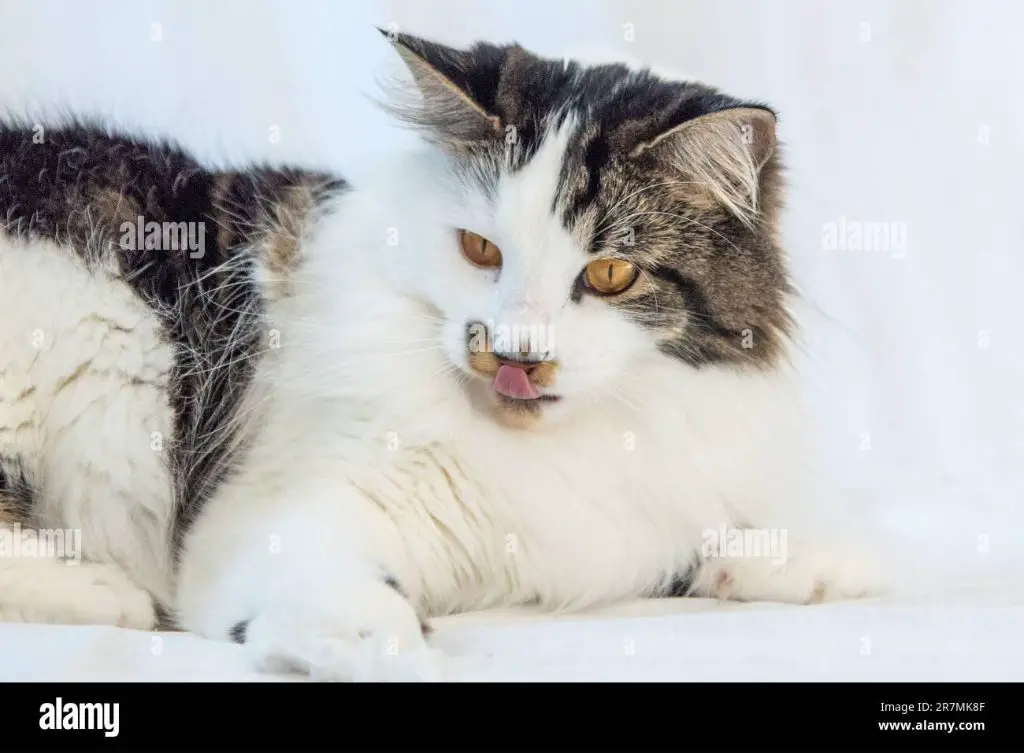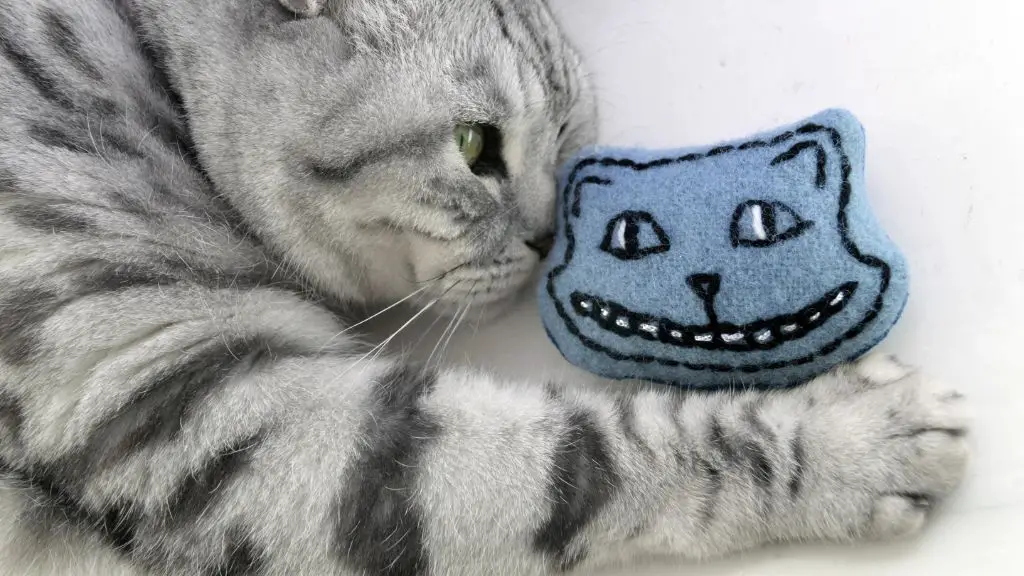What is catnip?
Catnip (Nepeta cataria) is a perennial herb in the mint family Lamiaceae. It is a short-lived perennial plant that grows to be 50-100 cm (20-40 in) tall and blooms from late spring to autumn (Wikipedia).
Catnip is native to central and southwestern Asia, Europe, and parts of Africa. It grows readily in temperate regions of North America and has naturalized throughout much of the northern half of the United States. Catnip thrives in soil with average fertility and good drainage and full sun (Wisconsin Horticulture).
The active chemical that causes a euphoric response in cats is an essential oil called nepetalactone, which can be found in the leaves and stems of the catnip plant. When cats ingest or smell nepetalactone, it binds to receptors in their brain and stimulates a response (Wikipedia).

Catnip response in cats
When cats smell or eat catnip, most exhibit a euphoric reaction. They may start rolling around, rubbing their face and body on the catnip, and become hyperactive. [Human Society]
This high-like reaction lasts about 10 minutes before the cat loses interest. During this time, some cats may meow loudly or growl at the same time as rubbing on the catnip. [Metro Vet Chicago]
The euphoric effects are short-lived, but harmless for most cats. After 10 minutes, as the catnip wears off, the cat will go back to its normal self.
Why cats love catnip
Cats love catnip because it contains the chemical compound nepetalactone, which mimics the feline sex pheromone and triggers instinctual/play behaviors in cats. When cats smell or eat catnip, the nepetalactone binds to receptors in their noses, which affects neurons in their brain that trigger those instinctual behaviors and provide a temporary sense of euphoria (Source 1). This causes cats to act playfully, roll around, paw at the catnip, and seem like they are intoxicated. The effects of catnip last about 10 minutes before wearing off.
Researchers have found that nepetalactone in catnip activates opioid receptors in cats’ brains that trigger behaviors linked to feeling pleasure and reward, similar to how opioids like heroin and morphine affect opioid receptors in people’s brains (Source 1). However, catnip is not addictive and completely safe for cats to experience this pleasurable high. The catnip response is instinctual and enhances cats’ play behaviors.
Not all cats react
According to research, only about 50-70% of cats respond positively to catnip (PetMD). Some cats have no reaction at all after being exposed to the herb. The reason for this is still unclear, but it seems to be an inherited sensitivity. Kittens under 3 months old also tend not to show interest in catnip – they don’t start to respond until they are around 6 months old.

The catnip response appears to be inherited as an autosomal dominant gene, which means the gene only needs to be passed down from one parent. However, some cats that have initially responded to catnip will lose interest as they grow older.
Catnip Safety
Catnip is generally considered safe for cats. There is no evidence that catnip is addictive or harmful to cats when used appropriately.
According to the ASPCA, catnip does not have any ingredients that can harm cats. The active chemical compound in catnip, called nepetalactone, binds to receptors in a cat’s nose and triggers a response that can cause euphoric-like behaviors like rolling, flipping, and rubbing. However, it is not an addictive substance.
While catnip itself is not harmful, PetMD notes that eating too much catnip can potentially cause vomiting or diarrhea. Cats absorb nepetalactone differently when ingesting versus smelling catnip. Therefore, it is recommended to use catnip as a scent rather than a food.

Overall, catnip is considered very safe for cats to enjoy. It is non-addictive and generally does not cause any harm. As with any treat, it should be used in moderation.
Using catnip
There are a few different ways to give your cat catnip:
- You can use loose dried catnip by sprinkling it on the floor, on cat toys, or adding a pinch to their food.
- Catnip spray can be spritzed on toys, scratching posts, and beds. This allows you to easily dispense it and control the amount.
- Prepackaged catnip toys are widely available with catnip stuffed inside. These provide longer-lasting exposure as your cat plays with and attacks the toy.
- Live catnip plants can be grown at home or purchased. Let your cat nibble on the leaves and stems.
Some cat owners believe homegrown catnip is more potent for cats than commercially processed catnip. Homegrown retains the plant’s essential oil, nepetalactone, at higher levels. Commercial catnip can lose potency when dried and packaged. However, commercial catnip is still enjoyed by most cats.
When using catnip, give your cat time to engage with it undisturbed. Then remove any unfinished catnip so it doesn’t lose potency. Store catnip in an airtight container out of sunlight.
Catnip spray
Catnip spray is a liquid spray containing catnip oil and water or alcohol that can be sprayed on toys or other surfaces to attract and stimulate cats. Commercial catnip sprays are available at most pet stores. It’s also easy to make your own homemade catnip spray.
Commercial catnip sprays contain essential oils from the catnip plant, often with additional ingredients like chamomile or lavender for calming effects. Popular brands include Kong Naturals Catnip Spray and SmartyKat Catnip Spray.[1]
To make your own DIY catnip spray at home, simply steep dried or fresh catnip in hot water, then cool and strain the mixture. Add vodka or rubbing alcohol as a preservative. Decide how strong you want the spray – more catnip to water makes it more potent. Spritz on toys, scratching posts, bedding or anywhere you want to attract your cat.[2] Homemade sprays are cheaper and allow you to control the ingredients.
Catnip Toys

Cats love playing with toys filled with catnip. Some popular catnip toy options include:
Stuffed toys – These plush, soft toys often contain loose catnip inside that cats can smell and rub against. The catnip encourages play and cats may kick, bite, or bunny kick the toys. Popular styles include mice, balls, snakes, and fish (https://www.chewy.com/b/catnip-toys-11130).
Catnip bubbles – These liquid bubbles contain catnip oil that bursts and releases the scent when cats pop them. Cats will endlessly chase and paw at the bubbles as they float through the air (https://www.amazon.com/catnip-toys/b?ie=UTF8&node=2975305011).
Tunnels/scratchers – Tunnels with dangling catnip toys inside encourage playful pouncing. Vertical scratching posts with catnip offer cats a combination of scratching and scent pleasure (https://www.meowijuana.com/collections/toys).
Other plants cats enjoy
Catnip isn’t the only plant that can make cats go crazy. There are a few other plants that elicit a similar response in cats when smelled or ingested:
Silver vine
Silver vine (source) contains compounds like actinidine that are thought to bind to olfactory receptors in cats, producing a catnip-like euphoric reaction. Many cats who don’t respond to catnip will respond to silver vine. It comes from the plant Actinidia polygama and can be purchased in dried leaf, powder, or spray form.
Cat thyme
Cat thyme (Teucrium marum) contains nepetalactone, the same compound found in catnip. When cats smell it, they often exhibit rolling, rubbing, and other playful behaviors. Cat thyme can be grown as a houseplant or outdoor herb garden.
Valerian
Valerian (Valeriana officinalis) root contains actinidine and valepotriates that cause a catnip-like reaction in many cats. The downside is that valerian has a very strong, unpleasant smell to humans. It can be fed to cats in dried root or tablet form.
Why cats love catnip
Cats go crazy for catnip because it activates an instinctual response that stimulates play and natural behaviors. Catnip contains a chemical called nepetalactone which triggers temporary euphoria when cats smell it 1. It activates their sensory receptors, leading to responses like sniffing, licking, rolling, and playfulness. For cats, catnip acts as fun enrichment and replicates natural stimulating plant scents they might find outdoors. The response is hereditary, with an estimated 50-70% of cats demonstrating a catnip reaction 2. Catnip engages a cat’s natural instincts to hunt, play, and enjoy sensory stimulation from plant aromas. It’s a safe way to activate feline behaviors in a controlled setting. Ultimately, cats just really seem to enjoy the euphoric yet relaxing feeling from nepetalactone. It makes for an entertaining cat toy or treat that most cats happily seek out.

